The severe operating environment that transfer station tipping floors are subjected to is often underappreciated during the design and construction of facilities, leading to premature wear and deterioration. These issues are further exacerbated by the heavy use and inherent challenges of maintaining and cleaning the facilities. However, with some changes in design and operational approaches and owner expectations, the unexpected premature wear and deterioration can be mitigated.
By R. Brett Holland, John Ralph Leak, Matthew R. Sherman, and Linda M. Seymour
The tipping floor of a solid waste transfer station plays a critical role in waste management operations, yet its importance in design and maintenance is often undervalued. Tipping floors are not just a normal slab-on-grade, but rather are subject to a relentless barrage of abrasion and chemical attack as solid waste is collected for transport to final disposal facilities. Aggressive use, a harsh environment, and lack of available down time for maintenance frequently lead to the quick deterioration of the concrete slab. In some cases, the concrete slab may lose up to one to two inches of thickness per year due to normal operating conditions. Our experience shows that designers and owners often underestimate the impact of design, operation, and maintenance of the tipping floor on the return on investment over the lifespan of a solid waste transfer station.
The tipping floor will wear out, deteriorate, and need repair or replacement many times over the course of the transfer station’s life; however, by understanding the harsh environment to which these slabs are exposed, we can better design and repair tipping floors to maximize their performance.
Our Challenge
Tipping floors are inherently subjected to extreme environments that are not captured by the provisions in current building codes. ACI 318 Building Code Requirements for Structural Concrete explicitly notes that “the Code does not include provisions for especially severe exposures.” In particular, tipping floors are subjected to the following that are not covered by typical durability requirements in building codes.
Abrasion
The concrete surface is subjected to near-constant scraping action of loader buckets picking up and moving solid waste during normal operation of the facility, and as a result the surface of the slab abrades with continued use. As the slabs wear, the surface will commonly get an uneven worn or “pebbled” texture since the cement paste in the concrete is typically more susceptible to abrasion than the aggregate (see Figure 1). Additionally, with continued abrasion, the reinforcement will become exposed (see Figure 2), which can lead to equipment damage and operating hazards on the floor. In severe cases, the abrasion can eventually wear through the entire slab and begin to erode and undercut the slab as the subgrade is removed during operations (see Figure 3). The abrasion from the loaders can especially be problematic at joint locations in the floor where the buckets can catch the potentially raised edges, causing raveling and spalling.
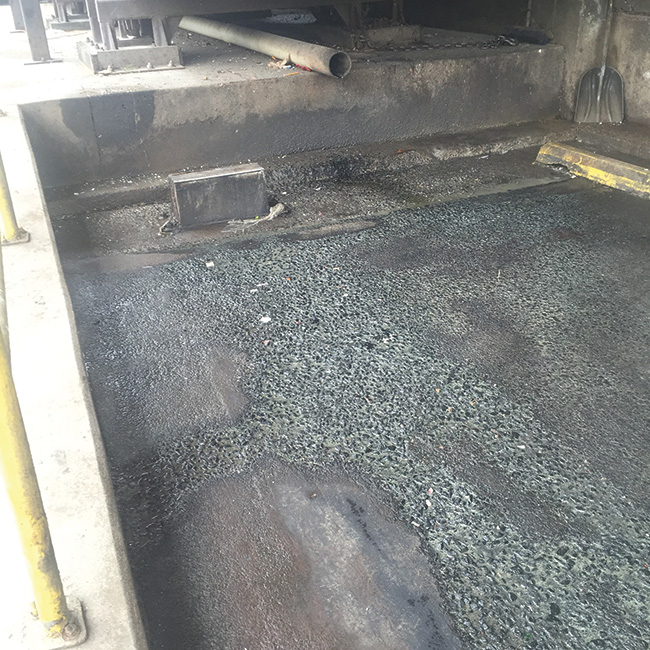
Tipping slab wear with pebbled surface.
Photos courtesy of Leak & Associates.
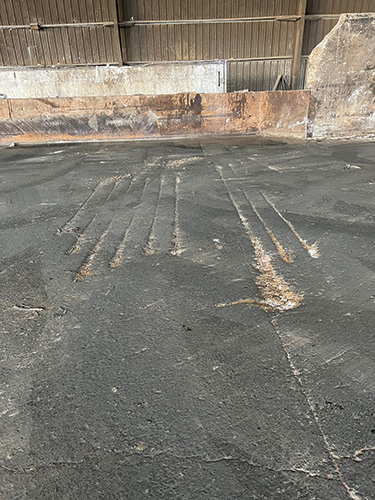
Heavy slab wear with reinforcement deterioration.
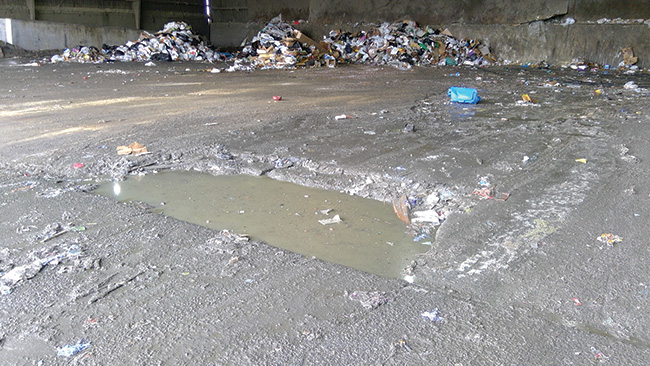
Extreme slab wear resulting in a hole through the tipping slab.
Leachate Attack
The surface of the concrete slabs is regularly exposed to leachate from the solid waste as it is handled in the facilities. Leachate is an acidic liquid that attacks the concrete surface by weakening and degrading the cement paste in the concrete. Depending on the types of solid waste handled by the facility, the aggressiveness of the leachate will vary, with facilities handling batteries frequently having some of the most acidic leachate. The leachate attack will degrade the surface and will accelerate the thickness loss of the slab due to abrasion during routine use, since the weakened paste will abrade more rapidly. Additionally, damage from abrasion removes the leachate-deteriorated concrete, continuously exposing new undamaged concrete to the leachate.
Maintenance and Cleaning Challenges
Many facility operators are unaware that their maintenance and cleaning practices can have a large impact on the performance of the slabs. When floors are not routinely washed or the tipping floor does not properly drain, the leachate is allowed to sit on the top surface of the slab and will accelerate damage. Similarly, when areas of damage, such as exposed reinforcement are not repaired, continued operation on the floor can lead to damage of adjacent portions of the slab.
Aggressive Equipment Use
Tipping floors are subject to relentless wear during operation, with overzealous operators frequently causing unintentional deterioration due to operating practices. Common sources of aggressive equipment use include practices, such as operating the loader with the bucket fully down in order to quickly move liquids and solids attached to the floor or even the use of damaged edges on loader buckets that can gouge the concrete slab (see Figure 4). Aggressive equipment will typically accelerate deterioration of the concrete slab and lead to additional repair challenges.
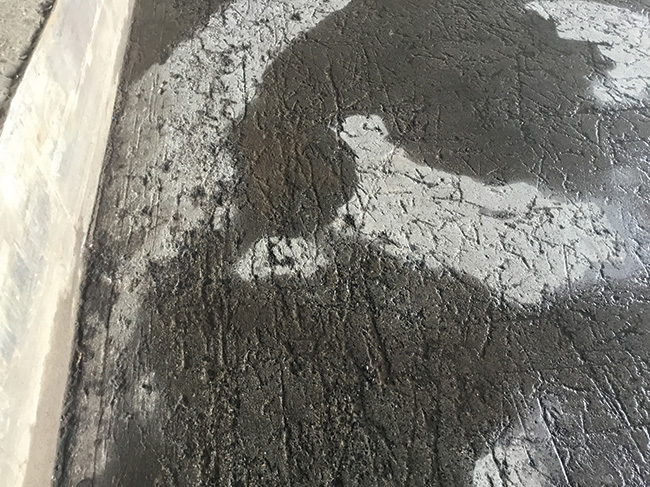
Tipping floor with localized gouges.
Strategies for Mitigating Damage on Existing Floors
To mitigate the effect of the aggressive wear and tear on existing concrete tipping floors, we recommend that facility owners and operators consider the following preventative actions.
Provide Regular Cleaning
Implementing regular cleanings to remove the acidic leachate liquid from the concrete surface reduces the chemical attack that softens the paste of the concrete. Regular cleaning makes the concrete surface less susceptible to abrasion and reduces deterioration.
Maintain Drainage
Maintaining proper drainage of the slab, including ensuring that trench and area drains are not clogged, will prevent ponding of leachate on the top surface of the slab. When used in conjunction with regular cleaning, this will prevent the leachate from permeating into the concrete surface and help prolong the useful life of the tipping floor.
Use Metal Edge Loaders
Using rubber-edged buckets tends to exacerbate the effect of normal wear and tear as the softer edge conforms to the surface profile of the concrete. This results in bucket pressure and abrasion along the entire edge of the bucket (including the paste) rather than the bucket riding atop the adjacent harder aggregates. This abrades the paste, leaving aggregates exposed and a pebbled slab appearance (see Figure 1). Pebbled slabs tend to not drain as well, further exacerbating leachate attack. Conversely, metal-edged buckets tend to concentrate pressure on the aggregates (which wear more slowly), resulting in more even concrete wear, improving the longevity of the slab (see Figure 5).
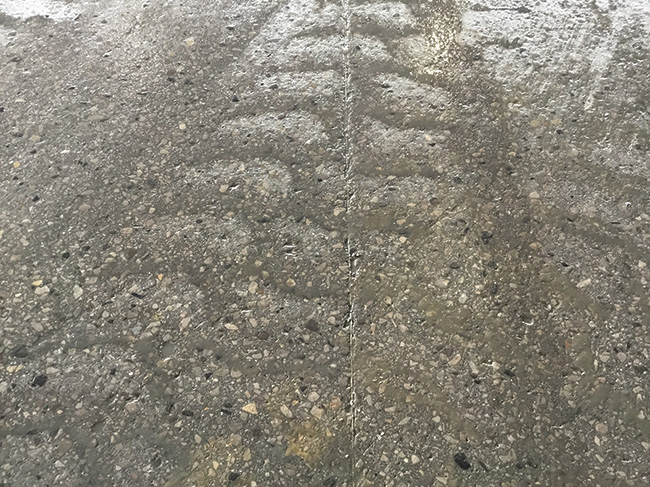
Consider Operational Factors
Because of the large number of cycles, small changes in operation can have a big effect. For example, rotating loading locations, changing tires to avoid loader tire slip, removing abrasives (especially ground glass and sand) from the slab surface, and minimizing loader pressure from “bucket down, wheel-up” scraping, and using only enough loader size for the job can all help to reduce wear.
Know When to Repair
Repairing and/or replacing tipping floors is part of owning and operating a transfer station. The concrete surface will eventually wear away regardless of preventative actions taken and owners and operators should have realistic expectations of the usable service life of the tipping floor slab. The usable life of the slabs can vary widely, depending on the original design of the slab, the operating and maintenance practices, and the type of waste handled on the floor. Incorporating large scale repair and replacement into capital planning efforts is critical and delaying this can lead to significantly more expensive repairs if the structural slab becomes compromised.
Design Concepts for New Floors
We frequently encounter new tipping floors designs that are purely based on the code prescribed loads and exposures, but that do not address the harsh working conditions present in transfer stations as described previously. The design of new facilities must consider not only structural loadings, but must also incorporate a fundamental understanding of the unique operational demands faced by transfer stations and the reality that the floors will eventually wear through. With tipping floors, the concept of designing something to never fail is often unrealistic or cost prohibitive.
Based on our experience, there are multiple items designers can incorporate into their designs to help with the durability and operational costs associated with tipping floors.
Incorporate Abrasion Resistance into the Design
Add additional requirements to the mix design to help improve abrasion resistance. Key components to improving abrasion resistance are the use of dense hard aggregates, minimized cementitious paste content, and use of a strong cement paste in the concrete. These concepts can be implemented in traditional ready-mixed concrete through specification of severe aggregate durability class, optimized aggregate gradation to minimize cement paste content, and moderate to low water-to-cementitious materials ratio (w/cm) limits. Additionally, low w/cm will help slow leachate attack damage to the slab. Alternatively, specialized armored toppings or integral hardeners can be used to further improve the abrasion resistance in new slabs.
Design for Wear
Incorporate sacrificial wear into the tipping slab design through the use of excess cover beyond code requirements. No matter how the floors are constructed, they will abrade over time. By incorporating this wear into the design, you will prolong the useful life of the floor before structural damage occurs to the slabs. Concepts for this include the use of large covers in conventional concrete slabs, the use of bonded armored toppings, or the use of sacrificial unbonded topping slabs.
Thoroughly Consider Jointing
Joint configuration and design is critically important due to the potential for loader edge catches, trapping of materials, and cracking. The slab jointing should be sufficient to minimize uncontrolled cracking without introducing excess joints. Also, curling of slab edges must be controlled through dowels, reinforcement, or other measures to prevent the formation of “catches” and load-related cracking when wheels pass over the joints.
Design for Replacement
Accept that the harsh environment will cause the tipping floor to wear out quickly, even with costly overlay materials, and instead design for easy replacement. Avoid having the structural slab also serve as the tipping floor exposed to loader traffic. One concept for this is through the use of a lower-cost sacrificial floor that is easy to replace, but has a potentially shorter service life. These types of options can help decrease the extent of repair costs for owners and, when maintained properly, serve for extended periods of time.
Closing Thoughts
Tipping floors are subjected to extremely harsh operating conditions and have an inevitably finite service life compared to most building structures. However, there are approaches that designers, owners, and operators can implement to help maximize the usable service life of the tipping floors. These changes require a shift in approach from all parties, including proper design to account for the harsh use, conscientious operating practices to limit unnecessary damage, consistent cleaning and maintenance of facilities, and, most importantly, realistic expectations and budgets related to the floors. With these changes, the usable life of facilities can be extended, and the impact of tipping floor repair and replacement on operations minimized. | WA
R. Brett Holland is a Senior Project Manager with Simpson Gumpertz & Heger, Inc. of Waltham, MA and is a registered Professional Engineer and Structural Engineer. Brett has more than 15 years of research and industry experience. He specializes in developing and implementing concrete for high-performance applications, concrete placement troubleshooting, specialized durability requirements, and investigating and repairing structures. He has investigated, designed, and rehabilitated a variety of structures, including historic stadiums, mechanically stabilized earth walls, precast concrete, concrete overlays, solid waste transfer facilities, and bridge and port structures. Brett can be reached at [email protected]
John Ralph Leak is the President of Leak & Associates, Inc. and a licensed commercial general contractor. John has more than 10 years of specialized experience in the construction and rehabilitation of trash transfer facilities. John has been in an active role of estimating, business development, and jobsite evaluations for Leak & Associates. John can be reached at [email protected].
Matthew R. Sherman is a Senior Principal with Simpson Gumpertz & Heger, Inc., and is a registered Professional Engineer and a Fellow of the American Concrete Institute and the International Concrete Repair Institute. Matthew has more than 25 years of experience in consulting and heavy construction throughout the U.S. His specialties include concrete materials, thermal and durability simulation, non-destructive testing, corrosion mitigation, and concrete repair. Matthew can be reached at [email protected]
Linda M. Seymour is a Project Consultant with Simpson Gumpertz & Heger, Inc. Linda has 10 years of research and industry experience. She specializes in concrete materials, including historic concrete formulations, durability, mix design, non-destructive testing, and structural investigations. She has performed materials characterization and structural investigations on concrete structures including infrastructure, industrial/manufacturing facilities, residential buildings, and ancient Roman monuments. Linda can be reached at [email protected]
